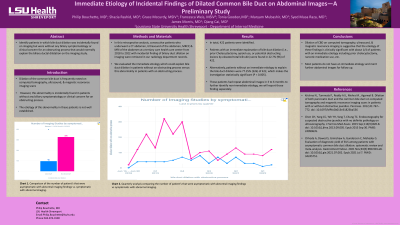Back


Poster Session B - Monday Morning
Category: Biliary/Pancreas
B0022 - Immediate Etiology of Incidental Finding of Dilated Common Bile Duct on Abdominal Images—A Preliminary Study
Monday, October 24, 2022
10:00 AM – 12:00 PM ET
Location: Crown Ballroom

Has Audio

Philip Bouchette, MD
Louisiana State University Health Sciences Center
Shreveport, LA
Presenting Author(s)
Philip Bouchette, MD1, Grace McCurdy, MS2, Francesca Weis, BS3, Tonia Gooden, MD1, Maryam Mubashir, MD1, Shazia Rashid, MD3, Syed Musa Raza, MD1, James Morris, MD, FACG4, Qiang Cai, MD3
1Louisiana State University Health Sciences Center, Shreveport, LA; 2Ochsner LSU Health Shreveport, Shreveport, LA; 3LSUHSC, Shreveport, LA; 4LSU Health Sciences Center, Shreveport, LA
Introduction: Dilation of the common bile duct is frequently noted on computed tomography, ultrasound, & magnetic resonance imaging scans; however, this abnormality is incidentally found in patients without any biliary symptomatology or clinical concern for an obstructing process. The etiology of this abnormality in these patients is not well established.
Methods: In this retrospective analysis, consecutive patients who underwent a CT abdomen, Ultrasound of the abdomen, MRCP, & MRI of the abdomen at a tertiary care health care center from 2018 to 2022 with incidental finding of biliary duct dilation on imaging were retrieved in our radiology department records. We evaluated the immediate etiology which could explain bile duct dilation in patients without an obstructing process versus this abnormality in patients with an obstructing process.
Results: In total, 422 patients were identified. Patients with an immediate explanation of bile duct dilation (i.e., prior Cholecystectomy, opioid use, or potential obstructing lesions by elevated total bilirubin) were found in 22.7% (96) of 422. Alternatively, patients without an immediate etiology to explain the bile duct dilation were 77.25% (326) of 422, which makes the investigation statistically significant (P < 0.005). Those patients had repeat abdominal images in 3 to 6 months to further identify non-immediate etiology, we will report those findings separately.
Discussion: Dilation of CBD on computed tomography, ultrasound, & magnetic resonance imaging is suggestive that the etiology of these findings is clinically significant with about 1/4 of patients with an immediate etiology including prior cholecystectomy, nacortic medication use, etc. Most patients do not have an immediate etiology and merit further abdominal images for follow up.

Disclosures:
Philip Bouchette, MD1, Grace McCurdy, MS2, Francesca Weis, BS3, Tonia Gooden, MD1, Maryam Mubashir, MD1, Shazia Rashid, MD3, Syed Musa Raza, MD1, James Morris, MD, FACG4, Qiang Cai, MD3. B0022 - Immediate Etiology of Incidental Finding of Dilated Common Bile Duct on Abdominal Images—A Preliminary Study, ACG 2022 Annual Scientific Meeting Abstracts. Charlotte, NC: American College of Gastroenterology.
1Louisiana State University Health Sciences Center, Shreveport, LA; 2Ochsner LSU Health Shreveport, Shreveport, LA; 3LSUHSC, Shreveport, LA; 4LSU Health Sciences Center, Shreveport, LA
Introduction: Dilation of the common bile duct is frequently noted on computed tomography, ultrasound, & magnetic resonance imaging scans; however, this abnormality is incidentally found in patients without any biliary symptomatology or clinical concern for an obstructing process. The etiology of this abnormality in these patients is not well established.
Methods: In this retrospective analysis, consecutive patients who underwent a CT abdomen, Ultrasound of the abdomen, MRCP, & MRI of the abdomen at a tertiary care health care center from 2018 to 2022 with incidental finding of biliary duct dilation on imaging were retrieved in our radiology department records. We evaluated the immediate etiology which could explain bile duct dilation in patients without an obstructing process versus this abnormality in patients with an obstructing process.
Results: In total, 422 patients were identified. Patients with an immediate explanation of bile duct dilation (i.e., prior Cholecystectomy, opioid use, or potential obstructing lesions by elevated total bilirubin) were found in 22.7% (96) of 422. Alternatively, patients without an immediate etiology to explain the bile duct dilation were 77.25% (326) of 422, which makes the investigation statistically significant (P < 0.005). Those patients had repeat abdominal images in 3 to 6 months to further identify non-immediate etiology, we will report those findings separately.
Discussion: Dilation of CBD on computed tomography, ultrasound, & magnetic resonance imaging is suggestive that the etiology of these findings is clinically significant with about 1/4 of patients with an immediate etiology including prior cholecystectomy, nacortic medication use, etc. Most patients do not have an immediate etiology and merit further abdominal images for follow up.

Figure: bile duct dilation in patients without an obstructing process versus this abnormality in patients with an obstructing process.
Disclosures:
Philip Bouchette indicated no relevant financial relationships.
Grace McCurdy indicated no relevant financial relationships.
Francesca Weis indicated no relevant financial relationships.
Tonia Gooden indicated no relevant financial relationships.
Maryam Mubashir indicated no relevant financial relationships.
Shazia Rashid indicated no relevant financial relationships.
Syed Musa Raza indicated no relevant financial relationships.
James Morris: Celgene – Grant/Research Support.
Qiang Cai indicated no relevant financial relationships.
Philip Bouchette, MD1, Grace McCurdy, MS2, Francesca Weis, BS3, Tonia Gooden, MD1, Maryam Mubashir, MD1, Shazia Rashid, MD3, Syed Musa Raza, MD1, James Morris, MD, FACG4, Qiang Cai, MD3. B0022 - Immediate Etiology of Incidental Finding of Dilated Common Bile Duct on Abdominal Images—A Preliminary Study, ACG 2022 Annual Scientific Meeting Abstracts. Charlotte, NC: American College of Gastroenterology.
